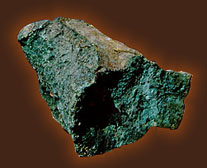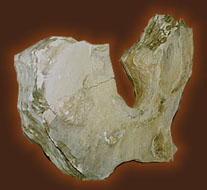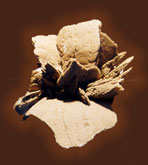
Profile
Marine Life
Habitats
Fauna
Donations- Collections
Contact
The tour of the Museum starts in the first hall which presents characteristic sedimentary and volcanic rocks from Troodos, from the Mesaoria plain and elsewhere.
 The
Troodos Mountain Range was formed some 90 million years ago, 8000 metres
below the sea level. These Mountains are exclusively made of ophiolithic
stones, abundant in asbestos, chromium, copper-bearing iron pyrite deposits
as well as interesting concentrations of gold and silver. This Range is
a fragment of oceanic crust and the upper mantle of the earth which was
detached from its initial position and gradually uplifted to its present
one, because of the descend of the African lithospheric plate under the
Eurasian plate. The uplift of Troodos resulted in the reversal of its stratigraphy.
When going up towards Troodos, from a stratigraphic point of view, one
descends from the bottom of an older ocean into the depths of the earth,
until the upper mantle zone.
The
Troodos Mountain Range was formed some 90 million years ago, 8000 metres
below the sea level. These Mountains are exclusively made of ophiolithic
stones, abundant in asbestos, chromium, copper-bearing iron pyrite deposits
as well as interesting concentrations of gold and silver. This Range is
a fragment of oceanic crust and the upper mantle of the earth which was
detached from its initial position and gradually uplifted to its present
one, because of the descend of the African lithospheric plate under the
Eurasian plate. The uplift of Troodos resulted in the reversal of its stratigraphy.
When going up towards Troodos, from a stratigraphic point of view, one
descends from the bottom of an older ocean into the depths of the earth,
until the upper mantle zone.
 The
Pentadactylos Range, the older of the two mountain massifs, was formed
at the time of the Alpine orogenesis (130-220 million years ago). It consists
of Permian, Carboniferous and Cretaceous limestone interrupted by basaltic
layers. On the lower slopes one comes across Miocene marl, sandstone
and conglomerates.
The
Pentadactylos Range, the older of the two mountain massifs, was formed
at the time of the Alpine orogenesis (130-220 million years ago). It consists
of Permian, Carboniferous and Cretaceous limestone interrupted by basaltic
layers. On the lower slopes one comes across Miocene marl, sandstone
and conglomerates.
 The
Central Plain (Mesaoria), which until about 120 thousand years ago was
a shallow sea, is formed chiefly of clay, marls and testaceous limestone
dated from 0,5 million to 5 million years, while in the areas around Troodos
we frequently come across chalk, limestone and gypsum. In some places of
Mesaoria, especially in the region close to Nicosia, we come across fossilised
shells and other marine life varieties.
The
Central Plain (Mesaoria), which until about 120 thousand years ago was
a shallow sea, is formed chiefly of clay, marls and testaceous limestone
dated from 0,5 million to 5 million years, while in the areas around Troodos
we frequently come across chalk, limestone and gypsum. In some places of
Mesaoria, especially in the region close to Nicosia, we come across fossilised
shells and other marine life varieties.
TOP OF THE PAGE